Social Media and Business Networking
VerifiedAdded on 2020/03/04
|13
|3171
|490
AI Summary
This assignment delves into the multifaceted impact of social media on businesses. It explores how social networking platforms contribute to firm growth and productivity, while also examining the risks associated with social media security. The importance of social capital and networking for small and medium-sized enterprises (SMEs) is highlighted, emphasizing strategies for successful business engagement through social media.
Contribute Materials
Your contribution can guide someone’s learning journey. Share your
documents today.

Running head: BUSINESS RESEARCH
Business Research
Name of the Student:
Student ID:
Author Note:
Business Research
Name of the Student:
Student ID:
Author Note:
Secure Best Marks with AI Grader
Need help grading? Try our AI Grader for instant feedback on your assignments.
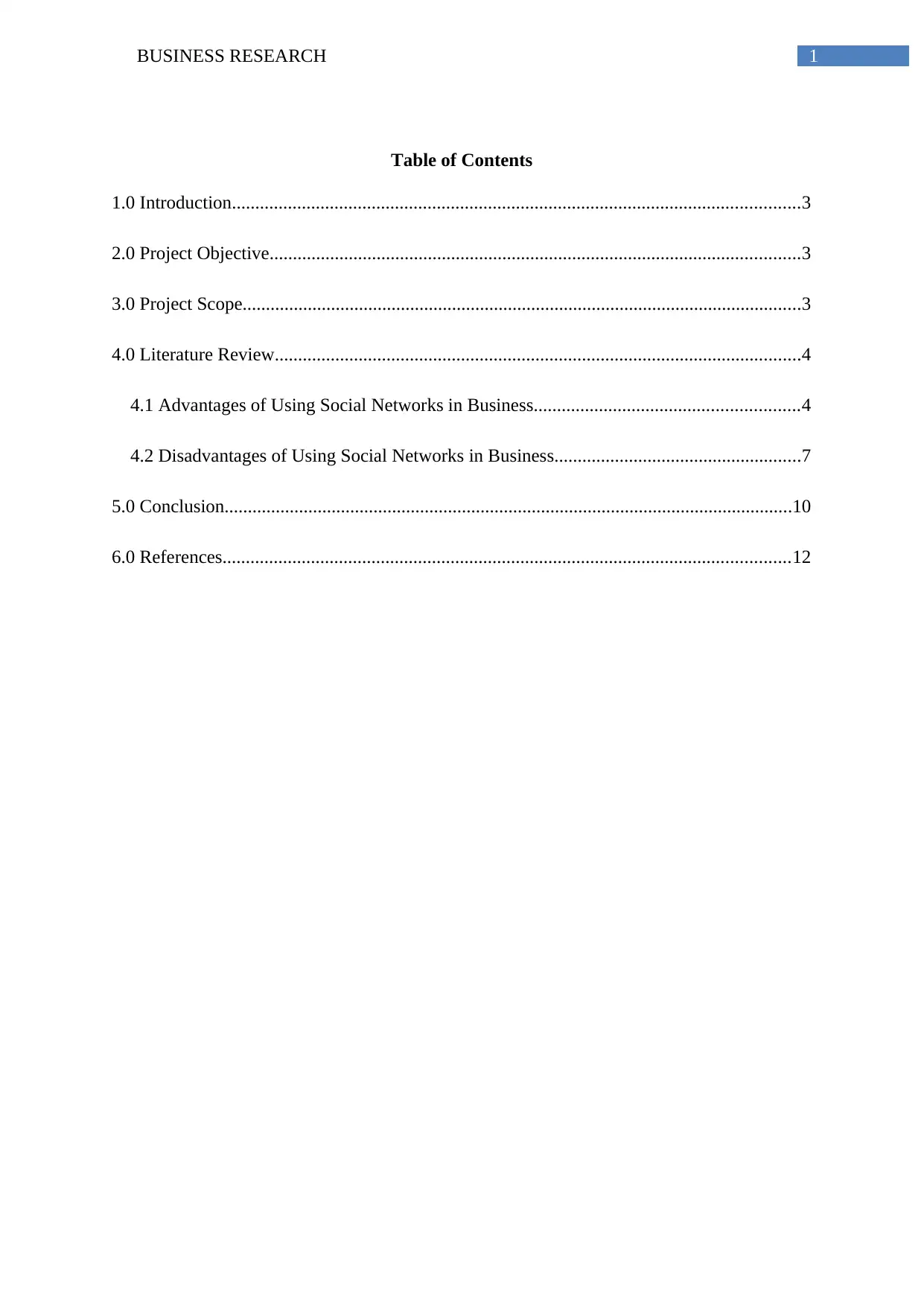
1BUSINESS RESEARCH
Table of Contents
1.0 Introduction..........................................................................................................................3
2.0 Project Objective..................................................................................................................3
3.0 Project Scope........................................................................................................................3
4.0 Literature Review.................................................................................................................4
4.1 Advantages of Using Social Networks in Business.........................................................4
4.2 Disadvantages of Using Social Networks in Business.....................................................7
5.0 Conclusion..........................................................................................................................10
6.0 References..........................................................................................................................12
Table of Contents
1.0 Introduction..........................................................................................................................3
2.0 Project Objective..................................................................................................................3
3.0 Project Scope........................................................................................................................3
4.0 Literature Review.................................................................................................................4
4.1 Advantages of Using Social Networks in Business.........................................................4
4.2 Disadvantages of Using Social Networks in Business.....................................................7
5.0 Conclusion..........................................................................................................................10
6.0 References..........................................................................................................................12
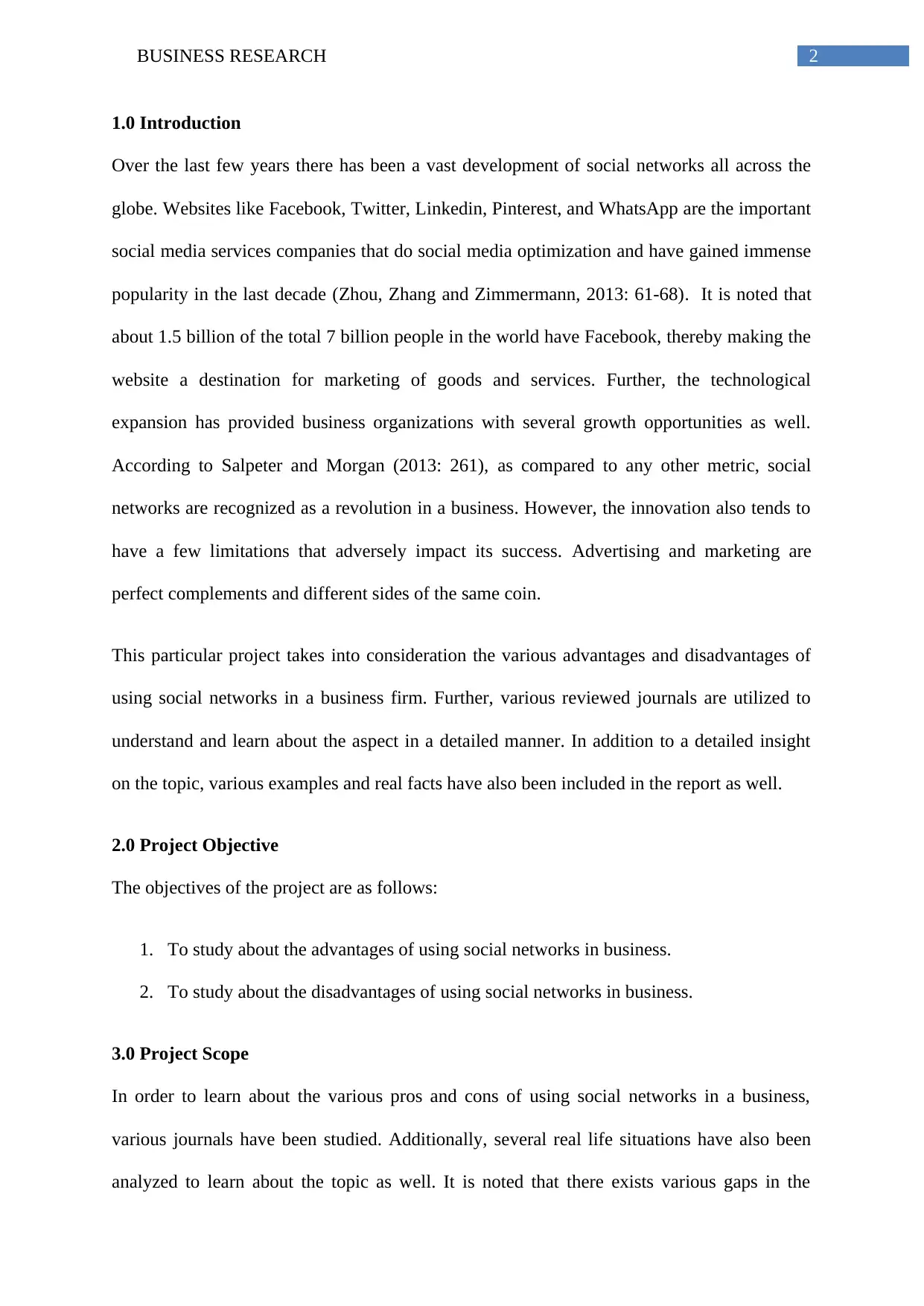
2BUSINESS RESEARCH
1.0 Introduction
Over the last few years there has been a vast development of social networks all across the
globe. Websites like Facebook, Twitter, Linkedin, Pinterest, and WhatsApp are the important
social media services companies that do social media optimization and have gained immense
popularity in the last decade (Zhou, Zhang and Zimmermann, 2013: 61-68). It is noted that
about 1.5 billion of the total 7 billion people in the world have Facebook, thereby making the
website a destination for marketing of goods and services. Further, the technological
expansion has provided business organizations with several growth opportunities as well.
According to Salpeter and Morgan (2013: 261), as compared to any other metric, social
networks are recognized as a revolution in a business. However, the innovation also tends to
have a few limitations that adversely impact its success. Advertising and marketing are
perfect complements and different sides of the same coin.
This particular project takes into consideration the various advantages and disadvantages of
using social networks in a business firm. Further, various reviewed journals are utilized to
understand and learn about the aspect in a detailed manner. In addition to a detailed insight
on the topic, various examples and real facts have also been included in the report as well.
2.0 Project Objective
The objectives of the project are as follows:
1. To study about the advantages of using social networks in business.
2. To study about the disadvantages of using social networks in business.
3.0 Project Scope
In order to learn about the various pros and cons of using social networks in a business,
various journals have been studied. Additionally, several real life situations have also been
analyzed to learn about the topic as well. It is noted that there exists various gaps in the
1.0 Introduction
Over the last few years there has been a vast development of social networks all across the
globe. Websites like Facebook, Twitter, Linkedin, Pinterest, and WhatsApp are the important
social media services companies that do social media optimization and have gained immense
popularity in the last decade (Zhou, Zhang and Zimmermann, 2013: 61-68). It is noted that
about 1.5 billion of the total 7 billion people in the world have Facebook, thereby making the
website a destination for marketing of goods and services. Further, the technological
expansion has provided business organizations with several growth opportunities as well.
According to Salpeter and Morgan (2013: 261), as compared to any other metric, social
networks are recognized as a revolution in a business. However, the innovation also tends to
have a few limitations that adversely impact its success. Advertising and marketing are
perfect complements and different sides of the same coin.
This particular project takes into consideration the various advantages and disadvantages of
using social networks in a business firm. Further, various reviewed journals are utilized to
understand and learn about the aspect in a detailed manner. In addition to a detailed insight
on the topic, various examples and real facts have also been included in the report as well.
2.0 Project Objective
The objectives of the project are as follows:
1. To study about the advantages of using social networks in business.
2. To study about the disadvantages of using social networks in business.
3.0 Project Scope
In order to learn about the various pros and cons of using social networks in a business,
various journals have been studied. Additionally, several real life situations have also been
analyzed to learn about the topic as well. It is noted that there exists various gaps in the
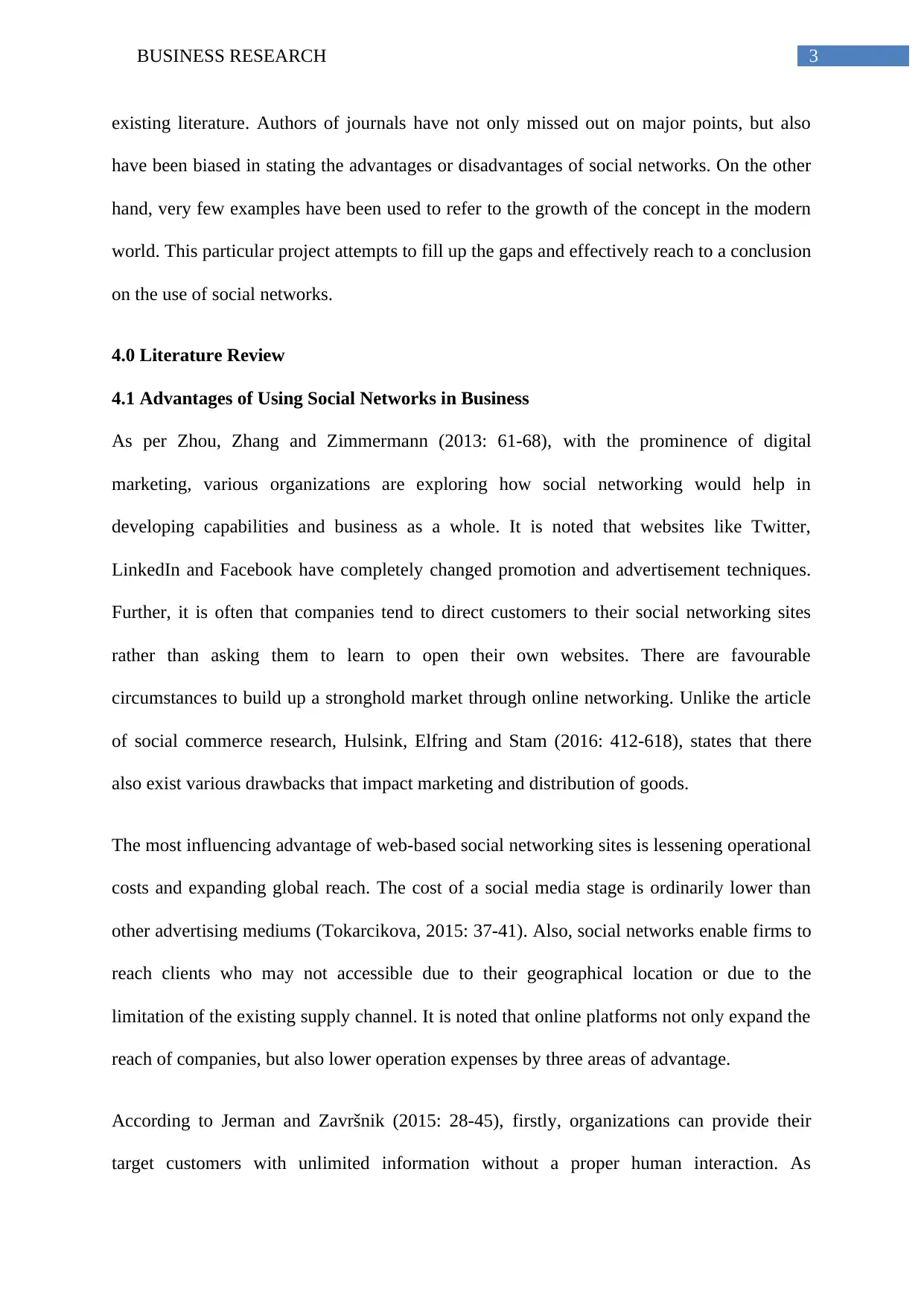
3BUSINESS RESEARCH
existing literature. Authors of journals have not only missed out on major points, but also
have been biased in stating the advantages or disadvantages of social networks. On the other
hand, very few examples have been used to refer to the growth of the concept in the modern
world. This particular project attempts to fill up the gaps and effectively reach to a conclusion
on the use of social networks.
4.0 Literature Review
4.1 Advantages of Using Social Networks in Business
As per Zhou, Zhang and Zimmermann (2013: 61-68), with the prominence of digital
marketing, various organizations are exploring how social networking would help in
developing capabilities and business as a whole. It is noted that websites like Twitter,
LinkedIn and Facebook have completely changed promotion and advertisement techniques.
Further, it is often that companies tend to direct customers to their social networking sites
rather than asking them to learn to open their own websites. There are favourable
circumstances to build up a stronghold market through online networking. Unlike the article
of social commerce research, Hulsink, Elfring and Stam (2016: 412-618), states that there
also exist various drawbacks that impact marketing and distribution of goods.
The most influencing advantage of web-based social networking sites is lessening operational
costs and expanding global reach. The cost of a social media stage is ordinarily lower than
other advertising mediums (Tokarcikova, 2015: 37-41). Also, social networks enable firms to
reach clients who may not accessible due to their geographical location or due to the
limitation of the existing supply channel. It is noted that online platforms not only expand the
reach of companies, but also lower operation expenses by three areas of advantage.
According to Jerman and Završnik (2015: 28-45), firstly, organizations can provide their
target customers with unlimited information without a proper human interaction. As
existing literature. Authors of journals have not only missed out on major points, but also
have been biased in stating the advantages or disadvantages of social networks. On the other
hand, very few examples have been used to refer to the growth of the concept in the modern
world. This particular project attempts to fill up the gaps and effectively reach to a conclusion
on the use of social networks.
4.0 Literature Review
4.1 Advantages of Using Social Networks in Business
As per Zhou, Zhang and Zimmermann (2013: 61-68), with the prominence of digital
marketing, various organizations are exploring how social networking would help in
developing capabilities and business as a whole. It is noted that websites like Twitter,
LinkedIn and Facebook have completely changed promotion and advertisement techniques.
Further, it is often that companies tend to direct customers to their social networking sites
rather than asking them to learn to open their own websites. There are favourable
circumstances to build up a stronghold market through online networking. Unlike the article
of social commerce research, Hulsink, Elfring and Stam (2016: 412-618), states that there
also exist various drawbacks that impact marketing and distribution of goods.
The most influencing advantage of web-based social networking sites is lessening operational
costs and expanding global reach. The cost of a social media stage is ordinarily lower than
other advertising mediums (Tokarcikova, 2015: 37-41). Also, social networks enable firms to
reach clients who may not accessible due to their geographical location or due to the
limitation of the existing supply channel. It is noted that online platforms not only expand the
reach of companies, but also lower operation expenses by three areas of advantage.
According to Jerman and Završnik (2015: 28-45), firstly, organizations can provide their
target customers with unlimited information without a proper human interaction. As
Secure Best Marks with AI Grader
Need help grading? Try our AI Grader for instant feedback on your assignments.
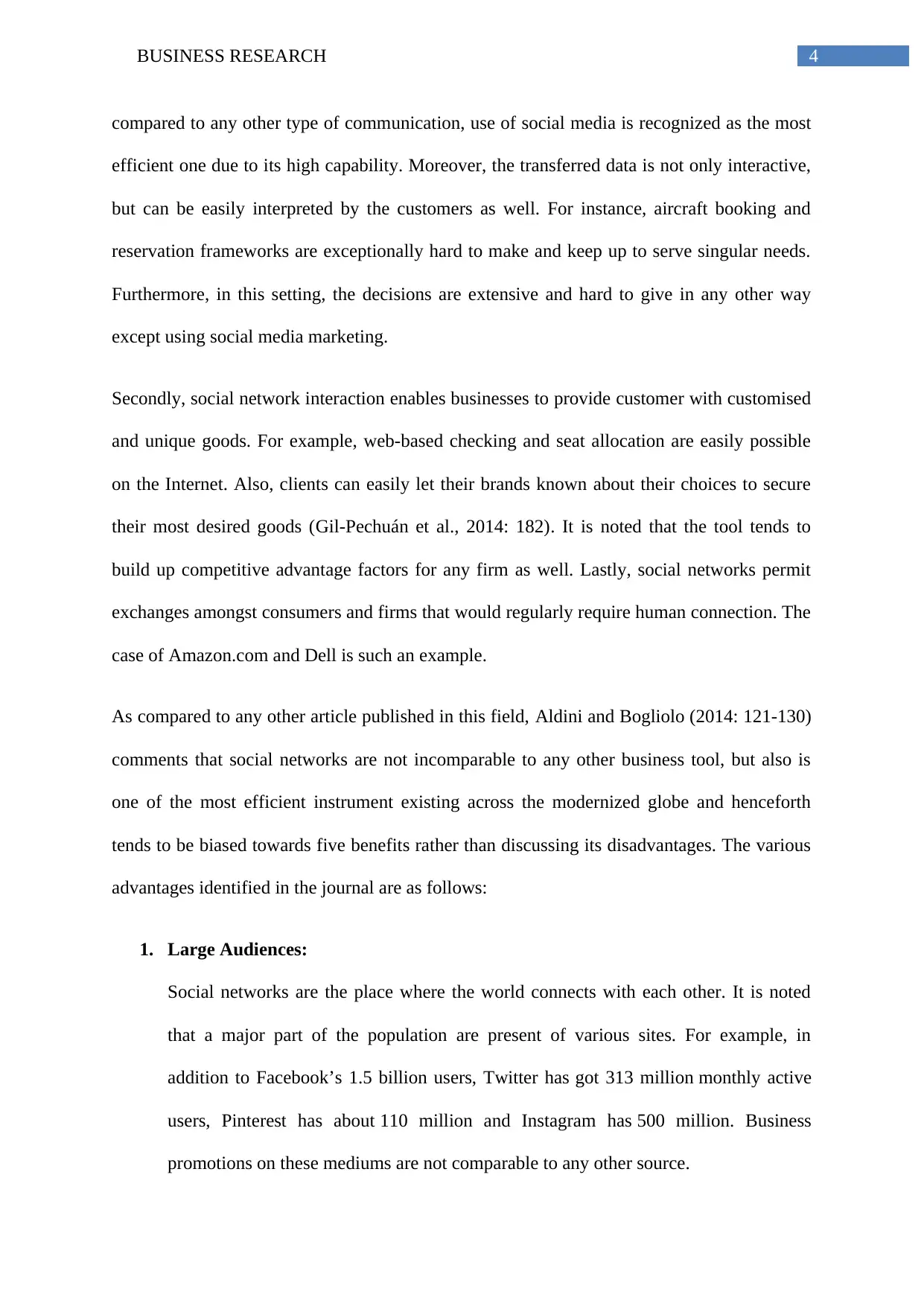
4BUSINESS RESEARCH
compared to any other type of communication, use of social media is recognized as the most
efficient one due to its high capability. Moreover, the transferred data is not only interactive,
but can be easily interpreted by the customers as well. For instance, aircraft booking and
reservation frameworks are exceptionally hard to make and keep up to serve singular needs.
Furthermore, in this setting, the decisions are extensive and hard to give in any other way
except using social media marketing.
Secondly, social network interaction enables businesses to provide customer with customised
and unique goods. For example, web-based checking and seat allocation are easily possible
on the Internet. Also, clients can easily let their brands known about their choices to secure
their most desired goods (Gil-Pechuán et al., 2014: 182) . It is noted that the tool tends to
build up competitive advantage factors for any firm as well. Lastly, social networks permit
exchanges amongst consumers and firms that would regularly require human connection. The
case of Amazon.com and Dell is such an example.
As compared to any other article published in this field, Aldini and Bogliolo (2014: 121-130)
comments that social networks are not incomparable to any other business tool, but also is
one of the most efficient instrument existing across the modernized globe and henceforth
tends to be biased towards five benefits rather than discussing its disadvantages. The various
advantages identified in the journal are as follows:
1. Large Audiences:
Social networks are the place where the world connects with each other. It is noted
that a major part of the population are present of various sites. For example, in
addition to Facebook’s 1.5 billion users, Twitter has got 313 million monthly active
users, Pinterest has about 110 million and Instagram has 500 million. Business
promotions on these mediums are not comparable to any other source.
compared to any other type of communication, use of social media is recognized as the most
efficient one due to its high capability. Moreover, the transferred data is not only interactive,
but can be easily interpreted by the customers as well. For instance, aircraft booking and
reservation frameworks are exceptionally hard to make and keep up to serve singular needs.
Furthermore, in this setting, the decisions are extensive and hard to give in any other way
except using social media marketing.
Secondly, social network interaction enables businesses to provide customer with customised
and unique goods. For example, web-based checking and seat allocation are easily possible
on the Internet. Also, clients can easily let their brands known about their choices to secure
their most desired goods (Gil-Pechuán et al., 2014: 182) . It is noted that the tool tends to
build up competitive advantage factors for any firm as well. Lastly, social networks permit
exchanges amongst consumers and firms that would regularly require human connection. The
case of Amazon.com and Dell is such an example.
As compared to any other article published in this field, Aldini and Bogliolo (2014: 121-130)
comments that social networks are not incomparable to any other business tool, but also is
one of the most efficient instrument existing across the modernized globe and henceforth
tends to be biased towards five benefits rather than discussing its disadvantages. The various
advantages identified in the journal are as follows:
1. Large Audiences:
Social networks are the place where the world connects with each other. It is noted
that a major part of the population are present of various sites. For example, in
addition to Facebook’s 1.5 billion users, Twitter has got 313 million monthly active
users, Pinterest has about 110 million and Instagram has 500 million. Business
promotions on these mediums are not comparable to any other source.
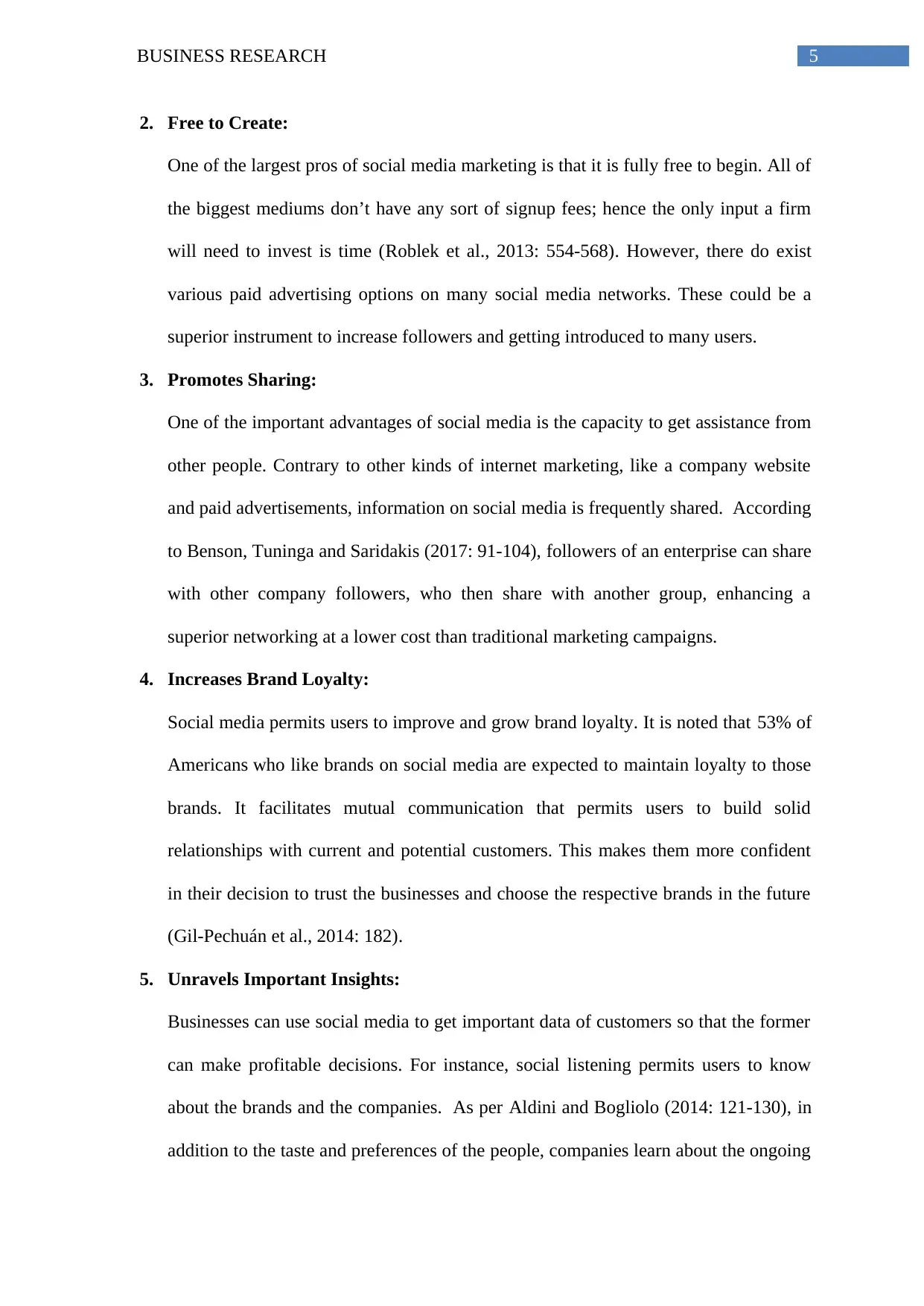
5BUSINESS RESEARCH
2. Free to Create:
One of the largest pros of social media marketing is that it is fully free to begin. All of
the biggest mediums don’t have any sort of signup fees; hence the only input a firm
will need to invest is time (Roblek et al., 2013: 554-568). However, there do exist
various paid advertising options on many social media networks. These could be a
superior instrument to increase followers and getting introduced to many users.
3. Promotes Sharing:
One of the important advantages of social media is the capacity to get assistance from
other people. Contrary to other kinds of internet marketing, like a company website
and paid advertisements, information on social media is frequently shared. According
to Benson, Tuninga and Saridakis (2017: 91-104), followers of an enterprise can share
with other company followers, who then share with another group, enhancing a
superior networking at a lower cost than traditional marketing campaigns.
4. Increases Brand Loyalty:
Social media permits users to improve and grow brand loyalty. It is noted that 53% of
Americans who like brands on social media are expected to maintain loyalty to those
brands. It facilitates mutual communication that permits users to build solid
relationships with current and potential customers. This makes them more confident
in their decision to trust the businesses and choose the respective brands in the future
(Gil-Pechuán et al., 2014: 182) .
5. Unravels Important Insights:
Businesses can use social media to get important data of customers so that the former
can make profitable decisions. For instance, social listening permits users to know
about the brands and the companies. As per Aldini and Bogliolo (2014: 121-130), in
addition to the taste and preferences of the people, companies learn about the ongoing
2. Free to Create:
One of the largest pros of social media marketing is that it is fully free to begin. All of
the biggest mediums don’t have any sort of signup fees; hence the only input a firm
will need to invest is time (Roblek et al., 2013: 554-568). However, there do exist
various paid advertising options on many social media networks. These could be a
superior instrument to increase followers and getting introduced to many users.
3. Promotes Sharing:
One of the important advantages of social media is the capacity to get assistance from
other people. Contrary to other kinds of internet marketing, like a company website
and paid advertisements, information on social media is frequently shared. According
to Benson, Tuninga and Saridakis (2017: 91-104), followers of an enterprise can share
with other company followers, who then share with another group, enhancing a
superior networking at a lower cost than traditional marketing campaigns.
4. Increases Brand Loyalty:
Social media permits users to improve and grow brand loyalty. It is noted that 53% of
Americans who like brands on social media are expected to maintain loyalty to those
brands. It facilitates mutual communication that permits users to build solid
relationships with current and potential customers. This makes them more confident
in their decision to trust the businesses and choose the respective brands in the future
(Gil-Pechuán et al., 2014: 182) .
5. Unravels Important Insights:
Businesses can use social media to get important data of customers so that the former
can make profitable decisions. For instance, social listening permits users to know
about the brands and the companies. As per Aldini and Bogliolo (2014: 121-130), in
addition to the taste and preferences of the people, companies learn about the ongoing
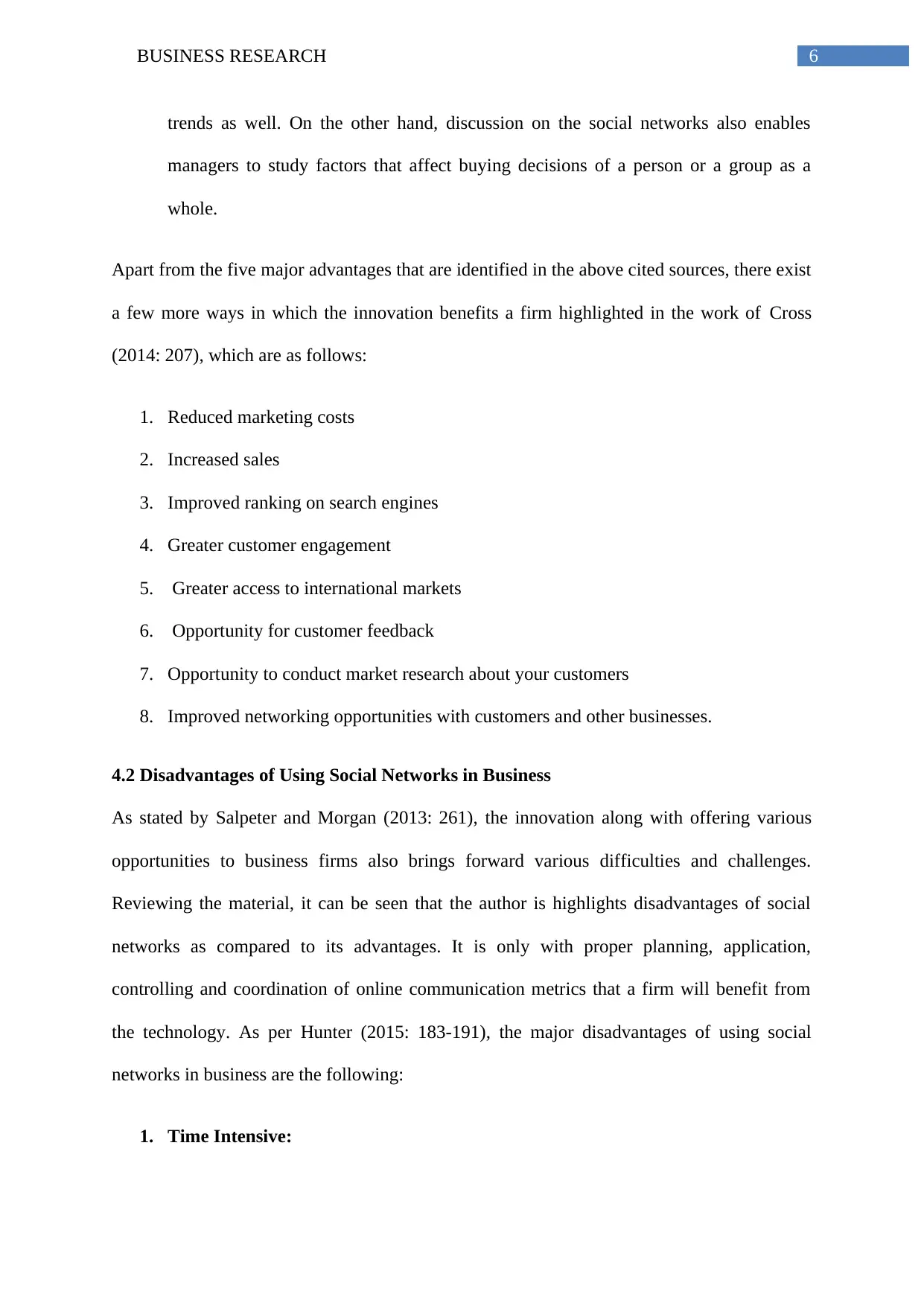
6BUSINESS RESEARCH
trends as well. On the other hand, discussion on the social networks also enables
managers to study factors that affect buying decisions of a person or a group as a
whole.
Apart from the five major advantages that are identified in the above cited sources, there exist
a few more ways in which the innovation benefits a firm highlighted in the work of Cross
(2014: 207), which are as follows:
1. Reduced marketing costs
2. Increased sales
3. Improved ranking on search engines
4. Greater customer engagement
5. Greater access to international markets
6. Opportunity for customer feedback
7. Opportunity to conduct market research about your customers
8. Improved networking opportunities with customers and other businesses.
4.2 Disadvantages of Using Social Networks in Business
As stated by Salpeter and Morgan (2013: 261), the innovation along with offering various
opportunities to business firms also brings forward various difficulties and challenges.
Reviewing the material, it can be seen that the author is highlights disadvantages of social
networks as compared to its advantages. It is only with proper planning, application,
controlling and coordination of online communication metrics that a firm will benefit from
the technology. As per Hunter (2015: 183-191), the major disadvantages of using social
networks in business are the following:
1. Time Intensive:
trends as well. On the other hand, discussion on the social networks also enables
managers to study factors that affect buying decisions of a person or a group as a
whole.
Apart from the five major advantages that are identified in the above cited sources, there exist
a few more ways in which the innovation benefits a firm highlighted in the work of Cross
(2014: 207), which are as follows:
1. Reduced marketing costs
2. Increased sales
3. Improved ranking on search engines
4. Greater customer engagement
5. Greater access to international markets
6. Opportunity for customer feedback
7. Opportunity to conduct market research about your customers
8. Improved networking opportunities with customers and other businesses.
4.2 Disadvantages of Using Social Networks in Business
As stated by Salpeter and Morgan (2013: 261), the innovation along with offering various
opportunities to business firms also brings forward various difficulties and challenges.
Reviewing the material, it can be seen that the author is highlights disadvantages of social
networks as compared to its advantages. It is only with proper planning, application,
controlling and coordination of online communication metrics that a firm will benefit from
the technology. As per Hunter (2015: 183-191), the major disadvantages of using social
networks in business are the following:
1. Time Intensive:
Paraphrase This Document
Need a fresh take? Get an instant paraphrase of this document with our AI Paraphraser
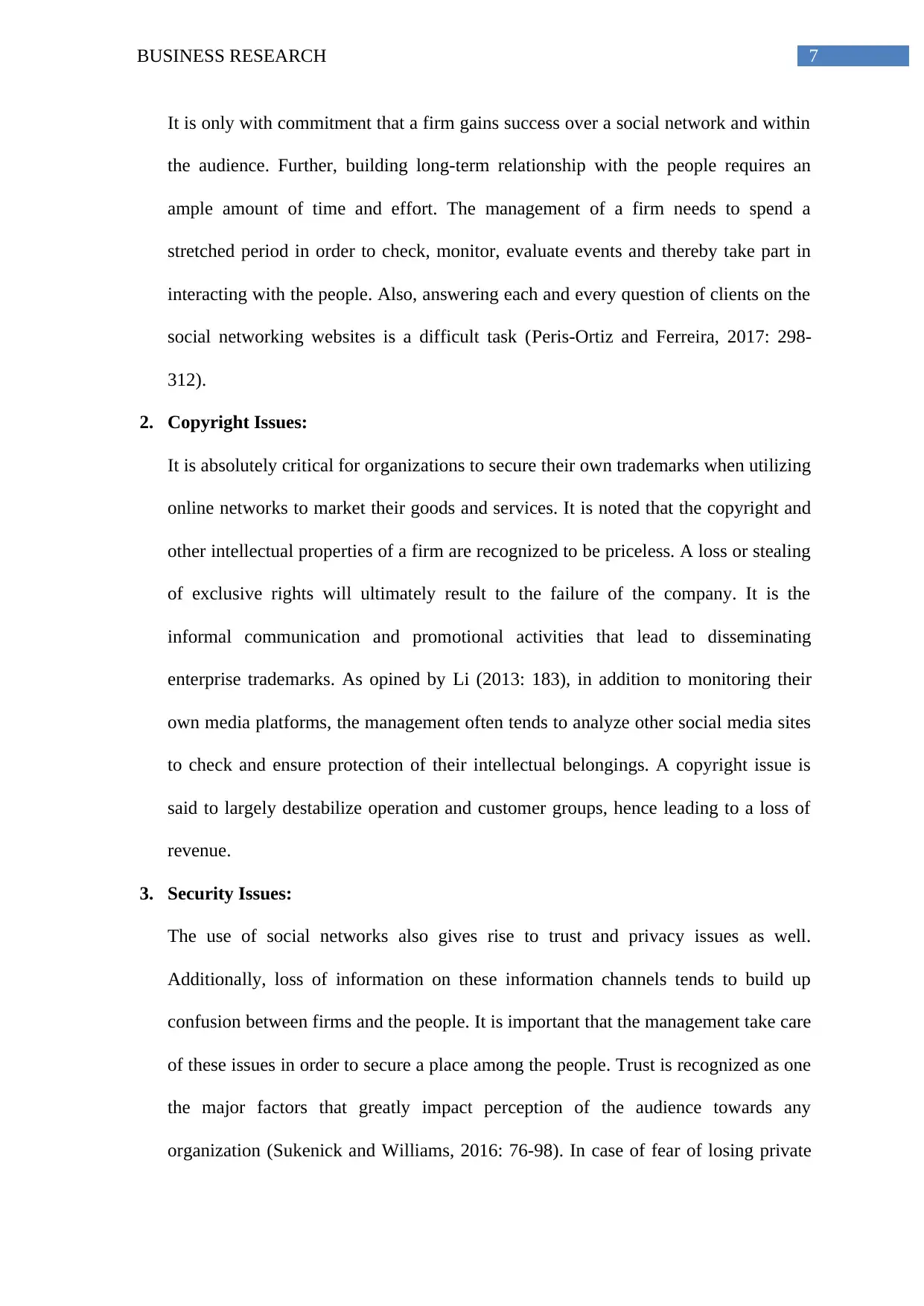
7BUSINESS RESEARCH
It is only with commitment that a firm gains success over a social network and within
the audience. Further, building long-term relationship with the people requires an
ample amount of time and effort. The management of a firm needs to spend a
stretched period in order to check, monitor, evaluate events and thereby take part in
interacting with the people. Also, answering each and every question of clients on the
social networking websites is a difficult task (Peris-Ortiz and Ferreira, 2017: 298-
312).
2. Copyright Issues:
It is absolutely critical for organizations to secure their own trademarks when utilizing
online networks to market their goods and services. It is noted that the copyright and
other intellectual properties of a firm are recognized to be priceless. A loss or stealing
of exclusive rights will ultimately result to the failure of the company. It is the
informal communication and promotional activities that lead to disseminating
enterprise trademarks. As opined by Li (2013: 183), in addition to monitoring their
own media platforms, the management often tends to analyze other social media sites
to check and ensure protection of their intellectual belongings. A copyright issue is
said to largely destabilize operation and customer groups, hence leading to a loss of
revenue.
3. Security Issues:
The use of social networks also gives rise to trust and privacy issues as well.
Additionally, loss of information on these information channels tends to build up
confusion between firms and the people. It is important that the management take care
of these issues in order to secure a place among the people. Trust is recognized as one
the major factors that greatly impact perception of the audience towards any
organization (Sukenick and Williams, 2016: 76-98). In case of fear of losing private
It is only with commitment that a firm gains success over a social network and within
the audience. Further, building long-term relationship with the people requires an
ample amount of time and effort. The management of a firm needs to spend a
stretched period in order to check, monitor, evaluate events and thereby take part in
interacting with the people. Also, answering each and every question of clients on the
social networking websites is a difficult task (Peris-Ortiz and Ferreira, 2017: 298-
312).
2. Copyright Issues:
It is absolutely critical for organizations to secure their own trademarks when utilizing
online networks to market their goods and services. It is noted that the copyright and
other intellectual properties of a firm are recognized to be priceless. A loss or stealing
of exclusive rights will ultimately result to the failure of the company. It is the
informal communication and promotional activities that lead to disseminating
enterprise trademarks. As opined by Li (2013: 183), in addition to monitoring their
own media platforms, the management often tends to analyze other social media sites
to check and ensure protection of their intellectual belongings. A copyright issue is
said to largely destabilize operation and customer groups, hence leading to a loss of
revenue.
3. Security Issues:
The use of social networks also gives rise to trust and privacy issues as well.
Additionally, loss of information on these information channels tends to build up
confusion between firms and the people. It is important that the management take care
of these issues in order to secure a place among the people. Trust is recognized as one
the major factors that greatly impact perception of the audience towards any
organization (Sukenick and Williams, 2016: 76-98). In case of fear of losing private
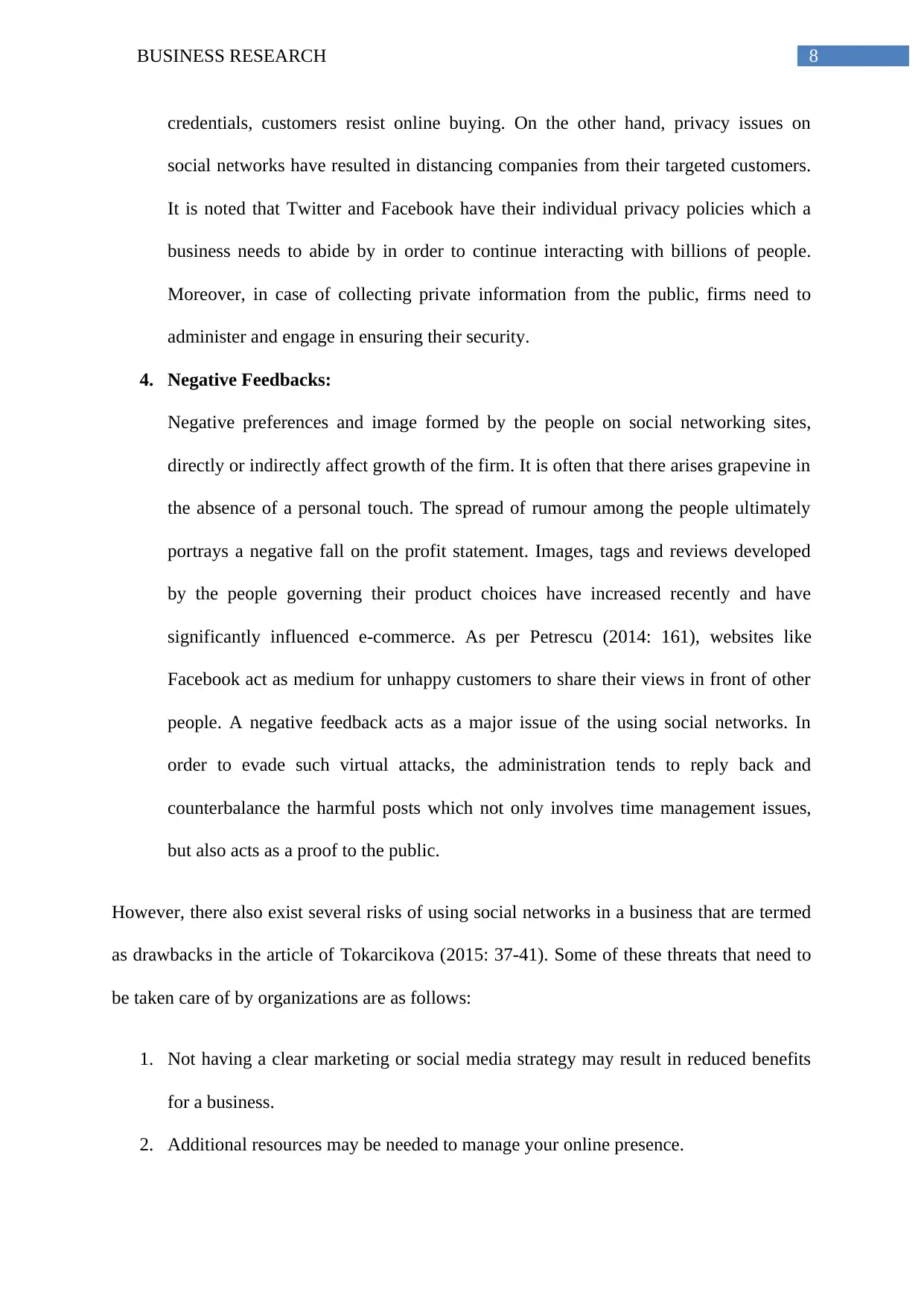
8BUSINESS RESEARCH
credentials, customers resist online buying. On the other hand, privacy issues on
social networks have resulted in distancing companies from their targeted customers.
It is noted that Twitter and Facebook have their individual privacy policies which a
business needs to abide by in order to continue interacting with billions of people.
Moreover, in case of collecting private information from the public, firms need to
administer and engage in ensuring their security.
4. Negative Feedbacks:
Negative preferences and image formed by the people on social networking sites,
directly or indirectly affect growth of the firm. It is often that there arises grapevine in
the absence of a personal touch. The spread of rumour among the people ultimately
portrays a negative fall on the profit statement. Images, tags and reviews developed
by the people governing their product choices have increased recently and have
significantly influenced e-commerce. As per Petrescu (2014: 161), websites like
Facebook act as medium for unhappy customers to share their views in front of other
people. A negative feedback acts as a major issue of the using social networks. In
order to evade such virtual attacks, the administration tends to reply back and
counterbalance the harmful posts which not only involves time management issues,
but also acts as a proof to the public.
However, there also exist several risks of using social networks in a business that are termed
as drawbacks in the article of Tokarcikova (2015: 37-41). Some of these threats that need to
be taken care of by organizations are as follows:
1. Not having a clear marketing or social media strategy may result in reduced benefits
for a business.
2. Additional resources may be needed to manage your online presence.
credentials, customers resist online buying. On the other hand, privacy issues on
social networks have resulted in distancing companies from their targeted customers.
It is noted that Twitter and Facebook have their individual privacy policies which a
business needs to abide by in order to continue interacting with billions of people.
Moreover, in case of collecting private information from the public, firms need to
administer and engage in ensuring their security.
4. Negative Feedbacks:
Negative preferences and image formed by the people on social networking sites,
directly or indirectly affect growth of the firm. It is often that there arises grapevine in
the absence of a personal touch. The spread of rumour among the people ultimately
portrays a negative fall on the profit statement. Images, tags and reviews developed
by the people governing their product choices have increased recently and have
significantly influenced e-commerce. As per Petrescu (2014: 161), websites like
Facebook act as medium for unhappy customers to share their views in front of other
people. A negative feedback acts as a major issue of the using social networks. In
order to evade such virtual attacks, the administration tends to reply back and
counterbalance the harmful posts which not only involves time management issues,
but also acts as a proof to the public.
However, there also exist several risks of using social networks in a business that are termed
as drawbacks in the article of Tokarcikova (2015: 37-41). Some of these threats that need to
be taken care of by organizations are as follows:
1. Not having a clear marketing or social media strategy may result in reduced benefits
for a business.
2. Additional resources may be needed to manage your online presence.
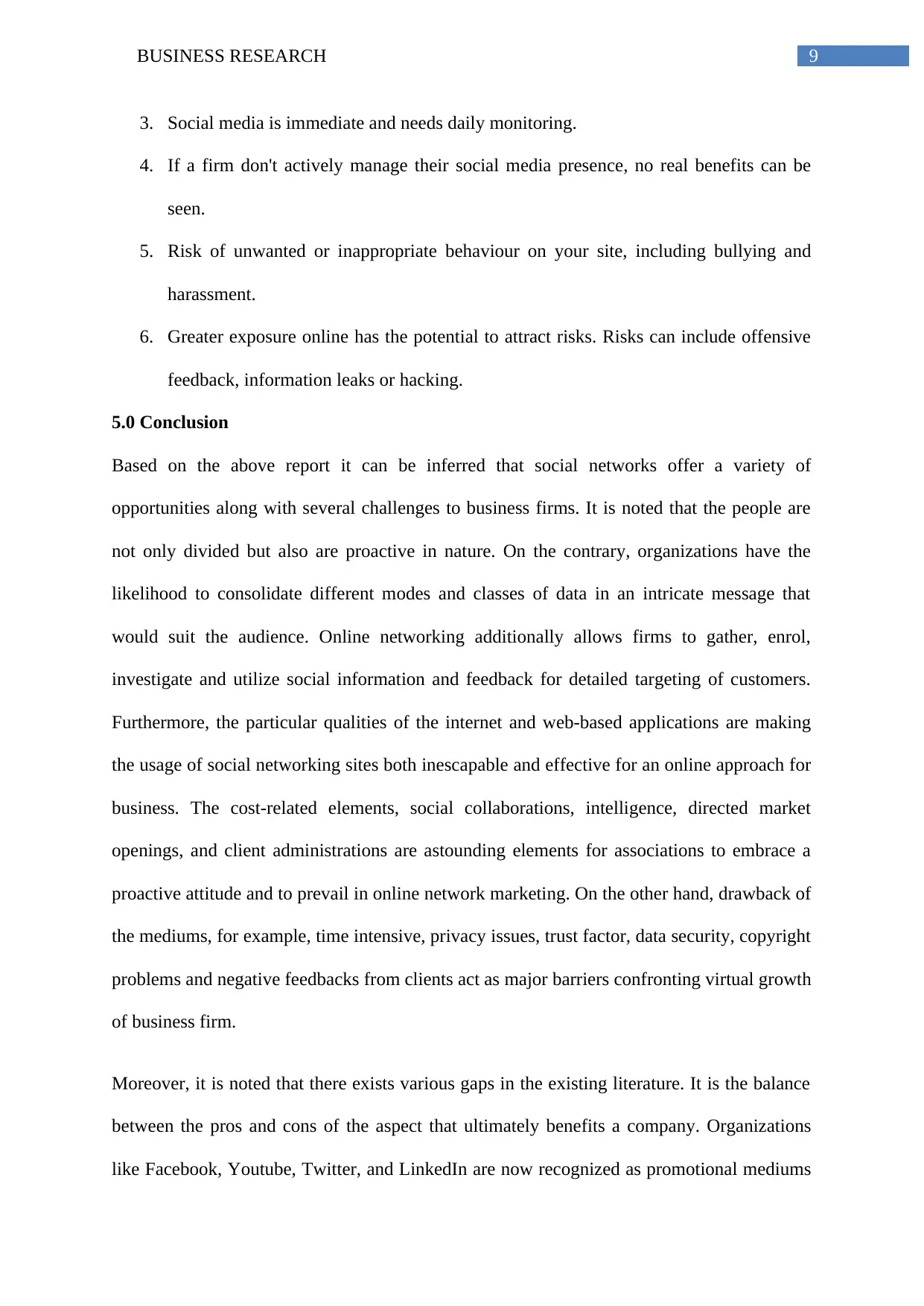
9BUSINESS RESEARCH
3. Social media is immediate and needs daily monitoring.
4. If a firm don't actively manage their social media presence, no real benefits can be
seen.
5. Risk of unwanted or inappropriate behaviour on your site, including bullying and
harassment.
6. Greater exposure online has the potential to attract risks. Risks can include offensive
feedback, information leaks or hacking.
5.0 Conclusion
Based on the above report it can be inferred that social networks offer a variety of
opportunities along with several challenges to business firms. It is noted that the people are
not only divided but also are proactive in nature. On the contrary, organizations have the
likelihood to consolidate different modes and classes of data in an intricate message that
would suit the audience. Online networking additionally allows firms to gather, enrol,
investigate and utilize social information and feedback for detailed targeting of customers.
Furthermore, the particular qualities of the internet and web-based applications are making
the usage of social networking sites both inescapable and effective for an online approach for
business. The cost-related elements, social collaborations, intelligence, directed market
openings, and client administrations are astounding elements for associations to embrace a
proactive attitude and to prevail in online network marketing. On the other hand, drawback of
the mediums, for example, time intensive, privacy issues, trust factor, data security, copyright
problems and negative feedbacks from clients act as major barriers confronting virtual growth
of business firm.
Moreover, it is noted that there exists various gaps in the existing literature. It is the balance
between the pros and cons of the aspect that ultimately benefits a company. Organizations
like Facebook, Youtube, Twitter, and LinkedIn are now recognized as promotional mediums
3. Social media is immediate and needs daily monitoring.
4. If a firm don't actively manage their social media presence, no real benefits can be
seen.
5. Risk of unwanted or inappropriate behaviour on your site, including bullying and
harassment.
6. Greater exposure online has the potential to attract risks. Risks can include offensive
feedback, information leaks or hacking.
5.0 Conclusion
Based on the above report it can be inferred that social networks offer a variety of
opportunities along with several challenges to business firms. It is noted that the people are
not only divided but also are proactive in nature. On the contrary, organizations have the
likelihood to consolidate different modes and classes of data in an intricate message that
would suit the audience. Online networking additionally allows firms to gather, enrol,
investigate and utilize social information and feedback for detailed targeting of customers.
Furthermore, the particular qualities of the internet and web-based applications are making
the usage of social networking sites both inescapable and effective for an online approach for
business. The cost-related elements, social collaborations, intelligence, directed market
openings, and client administrations are astounding elements for associations to embrace a
proactive attitude and to prevail in online network marketing. On the other hand, drawback of
the mediums, for example, time intensive, privacy issues, trust factor, data security, copyright
problems and negative feedbacks from clients act as major barriers confronting virtual growth
of business firm.
Moreover, it is noted that there exists various gaps in the existing literature. It is the balance
between the pros and cons of the aspect that ultimately benefits a company. Organizations
like Facebook, Youtube, Twitter, and LinkedIn are now recognized as promotional mediums
Secure Best Marks with AI Grader
Need help grading? Try our AI Grader for instant feedback on your assignments.

10BUSINESS RESEARCH
and a curial tool for business. Additionally, a properly planned and coordinated
communication-mix takes into consideration the several individual aspects of social
networks, thereby integrating it in a company in the most profitable manner.
and a curial tool for business. Additionally, a properly planned and coordinated
communication-mix takes into consideration the several individual aspects of social
networks, thereby integrating it in a company in the most profitable manner.
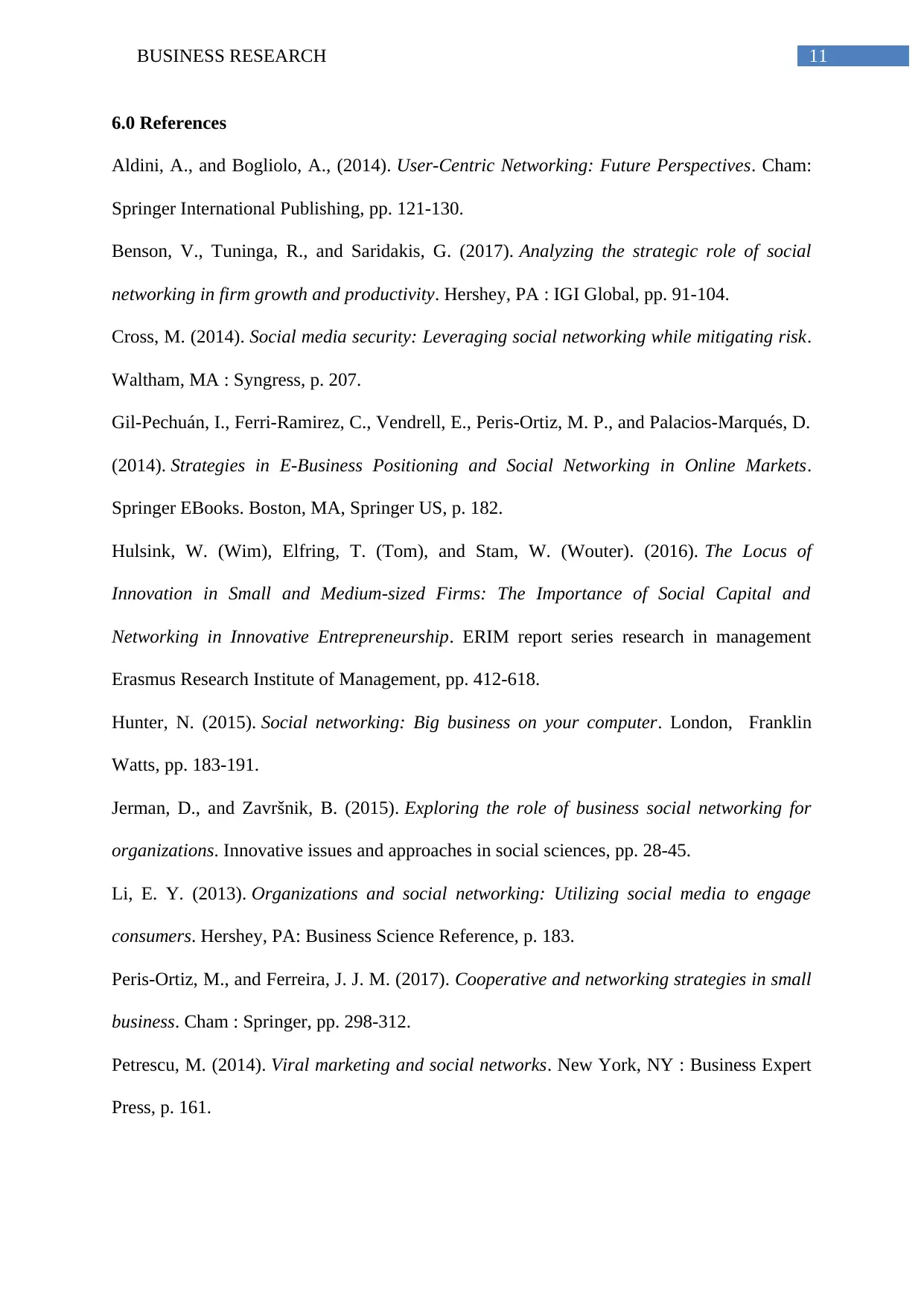
11BUSINESS RESEARCH
6.0 References
Aldini, A., and Bogliolo, A., (2014). User-Centric Networking: Future Perspectives. Cham:
Springer International Publishing, pp. 121-130.
Benson, V., Tuninga, R., and Saridakis, G. (2017). Analyzing the strategic role of social
networking in firm growth and productivity. Hershey, PA : IGI Global, pp. 91-104.
Cross, M. (2014). Social media security: Leveraging social networking while mitigating risk.
Waltham, MA : Syngress, p. 207.
Gil-Pechuán, I., Ferri-Ramirez, C., Vendrell, E., Peris-Ortiz, M. P., and Palacios-Marqués, D.
(2014). Strategies in E-Business Positioning and Social Networking in Online Markets.
Springer EBooks. Boston, MA, Springer US, p. 182.
Hulsink, W. (Wim), Elfring, T. (Tom), and Stam, W. (Wouter). (2016). The Locus of
Innovation in Small and Medium-sized Firms: The Importance of Social Capital and
Networking in Innovative Entrepreneurship. ERIM report series research in management
Erasmus Research Institute of Management, pp. 412-618.
Hunter, N. (2015). Social networking: Big business on your computer. London, Franklin
Watts, pp. 183-191.
Jerman, D., and Završnik, B. (2015). Exploring the role of business social networking for
organizations. Innovative issues and approaches in social sciences, pp. 28-45.
Li, E. Y. (2013). Organizations and social networking: Utilizing social media to engage
consumers. Hershey, PA: Business Science Reference, p. 183.
Peris-Ortiz, M., and Ferreira, J. J. M. (2017). Cooperative and networking strategies in small
business. Cham : Springer, pp. 298-312.
Petrescu, M. (2014). Viral marketing and social networks. New York, NY : Business Expert
Press, p. 161.
6.0 References
Aldini, A., and Bogliolo, A., (2014). User-Centric Networking: Future Perspectives. Cham:
Springer International Publishing, pp. 121-130.
Benson, V., Tuninga, R., and Saridakis, G. (2017). Analyzing the strategic role of social
networking in firm growth and productivity. Hershey, PA : IGI Global, pp. 91-104.
Cross, M. (2014). Social media security: Leveraging social networking while mitigating risk.
Waltham, MA : Syngress, p. 207.
Gil-Pechuán, I., Ferri-Ramirez, C., Vendrell, E., Peris-Ortiz, M. P., and Palacios-Marqués, D.
(2014). Strategies in E-Business Positioning and Social Networking in Online Markets.
Springer EBooks. Boston, MA, Springer US, p. 182.
Hulsink, W. (Wim), Elfring, T. (Tom), and Stam, W. (Wouter). (2016). The Locus of
Innovation in Small and Medium-sized Firms: The Importance of Social Capital and
Networking in Innovative Entrepreneurship. ERIM report series research in management
Erasmus Research Institute of Management, pp. 412-618.
Hunter, N. (2015). Social networking: Big business on your computer. London, Franklin
Watts, pp. 183-191.
Jerman, D., and Završnik, B. (2015). Exploring the role of business social networking for
organizations. Innovative issues and approaches in social sciences, pp. 28-45.
Li, E. Y. (2013). Organizations and social networking: Utilizing social media to engage
consumers. Hershey, PA: Business Science Reference, p. 183.
Peris-Ortiz, M., and Ferreira, J. J. M. (2017). Cooperative and networking strategies in small
business. Cham : Springer, pp. 298-312.
Petrescu, M. (2014). Viral marketing and social networks. New York, NY : Business Expert
Press, p. 161.
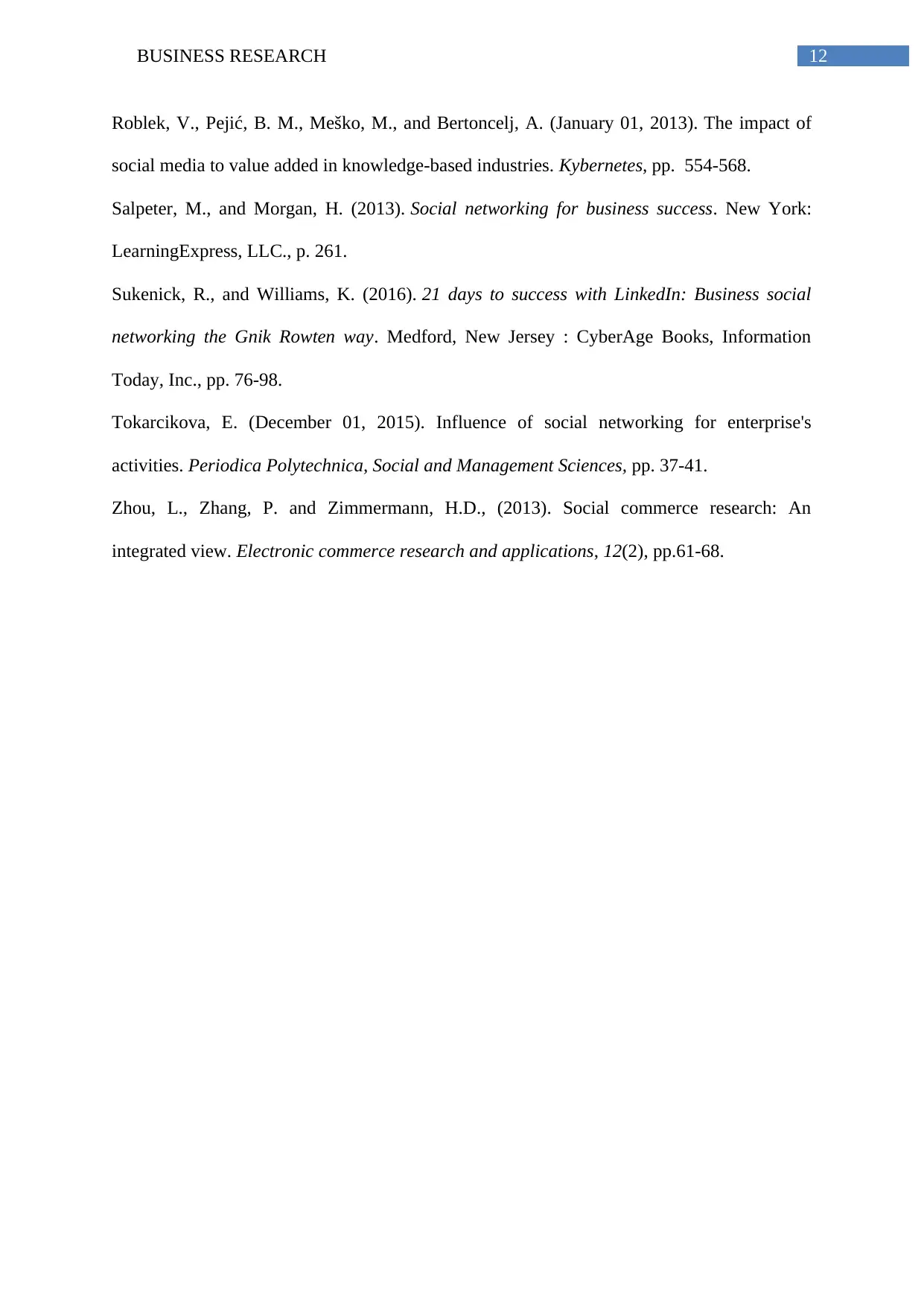
12BUSINESS RESEARCH
Roblek, V., Pejić, B. M., Meško, M., and Bertoncelj, A. (January 01, 2013). The impact of
social media to value added in knowledge-based industries. Kybernetes, pp. 554-568.
Salpeter, M., and Morgan, H. (2013). Social networking for business success. New York:
LearningExpress, LLC., p. 261.
Sukenick, R., and Williams, K. (2016). 21 days to success with LinkedIn: Business social
networking the Gnik Rowten way. Medford, New Jersey : CyberAge Books, Information
Today, Inc., pp. 76-98.
Tokarcikova, E. (December 01, 2015). Influence of social networking for enterprise's
activities. Periodica Polytechnica, Social and Management Sciences, pp. 37-41.
Zhou, L., Zhang, P. and Zimmermann, H.D., (2013). Social commerce research: An
integrated view. Electronic commerce research and applications, 12(2), pp.61-68.
Roblek, V., Pejić, B. M., Meško, M., and Bertoncelj, A. (January 01, 2013). The impact of
social media to value added in knowledge-based industries. Kybernetes, pp. 554-568.
Salpeter, M., and Morgan, H. (2013). Social networking for business success. New York:
LearningExpress, LLC., p. 261.
Sukenick, R., and Williams, K. (2016). 21 days to success with LinkedIn: Business social
networking the Gnik Rowten way. Medford, New Jersey : CyberAge Books, Information
Today, Inc., pp. 76-98.
Tokarcikova, E. (December 01, 2015). Influence of social networking for enterprise's
activities. Periodica Polytechnica, Social and Management Sciences, pp. 37-41.
Zhou, L., Zhang, P. and Zimmermann, H.D., (2013). Social commerce research: An
integrated view. Electronic commerce research and applications, 12(2), pp.61-68.
1 out of 13
Related Documents
Your All-in-One AI-Powered Toolkit for Academic Success.
+13062052269
info@desklib.com
Available 24*7 on WhatsApp / Email
![[object Object]](/_next/static/media/star-bottom.7253800d.svg)
Unlock your academic potential
© 2024 | Zucol Services PVT LTD | All rights reserved.




